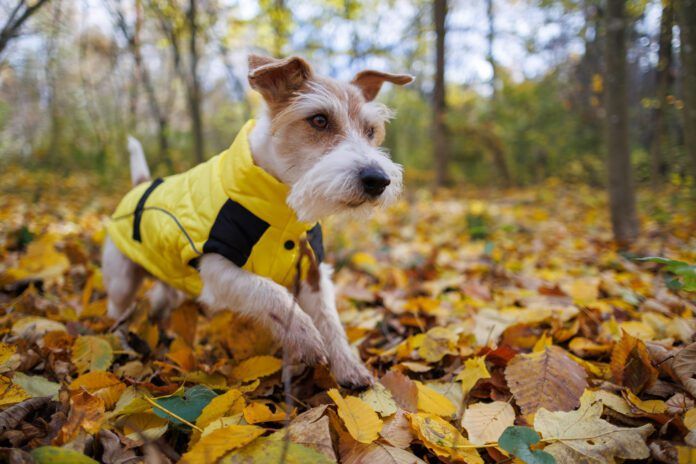The Best Flea & Tick Shampoos for Dogs
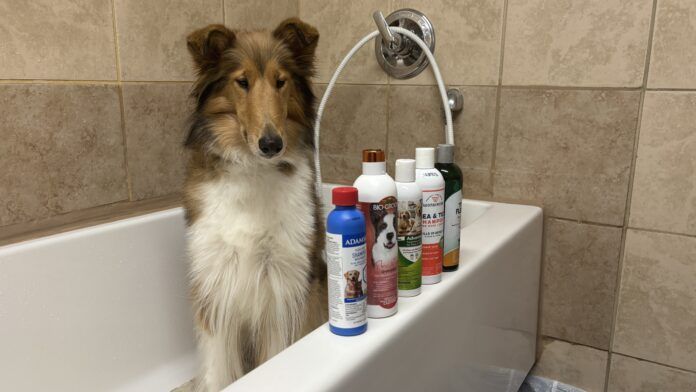
Could My Dog Have ADHD?

Join Whole Dog Journal
Already a member?
Click Here to Sign In | Forgot your password? | Activate Web AccessWhy Do Dogs Have Tails?
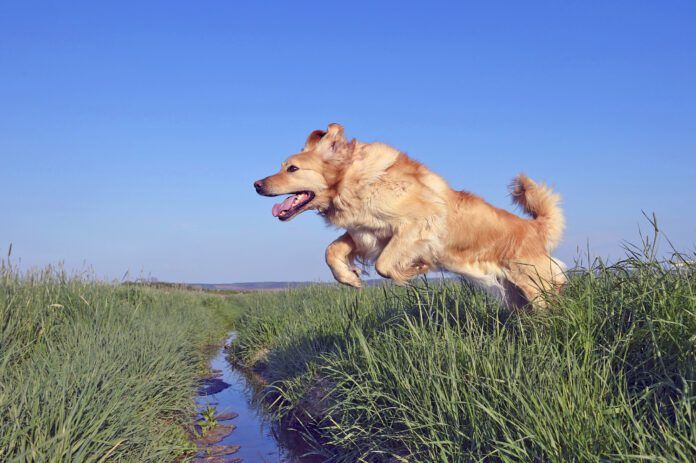
A wagging tail is often seen as a sign of a happy dog. But your dog’s tail is far more than a barometer of emotion: It’s a complex and highly functional extension of its spine that serves a variety of purposes.
Do Dogs Have Bones in Their Tails?
The short answer is, yes. A dog’s tail is a series of vertebrae that gets progressively smaller toward the tip. On average, a dog’s tail has between five and 20 vertebrae, which are surrounded by muscles, nerves, and blood vessels. “Dogs’ spines continue in their tails with caudal vertebrae. The number of caudal vertebrae varies between dogs,” says Jamie Whittenburg, DVM, chief of staff at Kingsgate Animal Hospital in Lubbock, Texas.
According to Bond Vets, a chain of veterinary clinics, because tails are made up of skeletal muscle and tendons/ligaments which, unlike the smooth muscle of intestines and blood vessels, it is under voluntary control. “It stands to reason that dogs have control over their tail movements just like they do over their leg movements,” says Bond Vets.
What’s the Purpose of a Dog’s Tail?
Your dog’s tail communicates a wide range of emotions and intentions to other dogs and to people. “Each dog is unique and has their own way to communicate their feelings and emotions,” says Dr. Whittenburg. “Some dogs use their tails more than others.”
And some of those uses are often misinterpreted, according to Tufts University. For example, a relaxed, friendly dog may have a tail that wags in a swishing or circular motion. However, if a dog is feeling anxious, fearful, or stressed, its tail is often lowered or tucked between its legs.
Lastly, a dog that is aroused or hyper alert may hold its tail up high and wag it in a stiff, quick motion. Rather than a sign of friendliness, it indicates a state of excitement, alertness, or aggression.
In addition to communications, a dog’s tail serves especially when the dog is running, jumping, or navigating uneven terrain. Fast, agile breeds use their tails like a rudder to shift weight and maintain stability. Think of your dog’s tail like a tightrope walker’s pole, which is used to constantly adjust their center of gravity.
What Is Dog Tail Docking?
Dog tail docking is the controversial practice of surgically removing part or all of a dog’s tail. It is typically performed on puppies that are only a few days old, often without anesthesia.
Historically, tail docking was performed on working dogs to prevent injuries that might occur while hunting or herding. It was also done for cosmetic reasons or to conform to specific breed standards set by kennel clubs.
However, the practice is now a subject of much debate. “Removing a dog’s tail can affect its communication and hinder the ability to express and convey emotions. I believe that tail docking is an unnecessary and cruel cosmetic procedure that negatively impacts dogs,” says Whittenburg.
Many veterinary organizations, including the American Veterinary Medical Association (AVMA) and the Royal Society for the Prevention of Cruelty to Animals (RSPCA), agree and oppose the procedure.
The AVMA finds the question isn’t how harmful the procedure is but whether there is justification for removing it. “The only benefit that appears to be derived from cosmetic tail docking of dogs is the owner’s impression of a pleasing appearance. In the opinion of the AVMA, this is insufficient justification for performing a surgical procedure. deeming it medically unnecessary and a cause of pain and distress for the dog.”
The AVMA and RSPCA argue that a dog’s tail is essential for its well-being and communication, and as a result, the practice is now banned or heavily restricted in many countries.
Ultimately, the practice of tail docking is considered by most of the veterinary community to be a painful and unnecessary mutilation that deprives a dog of an integral part of its anatomy, essential for communication and overall well-being.
Broken and Injured Tails
Because it’s made up of vertebrae, your dog’s tail can be broken or injured.
Dr. Whittenburg says one of the common injuries she sees is degloving, where the skin is forcibly ripped from the tail. “This happens for a variety of reasons,” she says, “including being hit by a car and having their tails accidentally shut in doors.”
And then there’s “happy tail.” This also occurs frequently and is due to the impact of an exuberantly wagging tail hitting the wall and other objects. “The end of the tail splits open and typically there is a lot of blood seen,” says Dr. Whittenburg.
While typically not emergencies, these tail injuries expose delicate nerves that cause pain, so veterinary intervention is advised. “Sometimes, bandaging the injured area and giving antibiotics and pain medication will prevent infection, calm the nerves, and allow the tail to heal. In severe, chronic cases where the wagging will not stop and the injury will not heal, the best solution is surgical shortening of the tail,” advises the VCA Animal Hospitals.
Ultimately, a tail is a multifaceted part of your dog’s anatomy. It’s an indispensable tool for balance and communication, and a vital component of its overall well-being. Understanding the function of the tail—beyond just a wag—lets you better interpret your dog’s emotions, appreciate their unique physical abilities, and advocate for their health.
Temporary Fences for Dogs
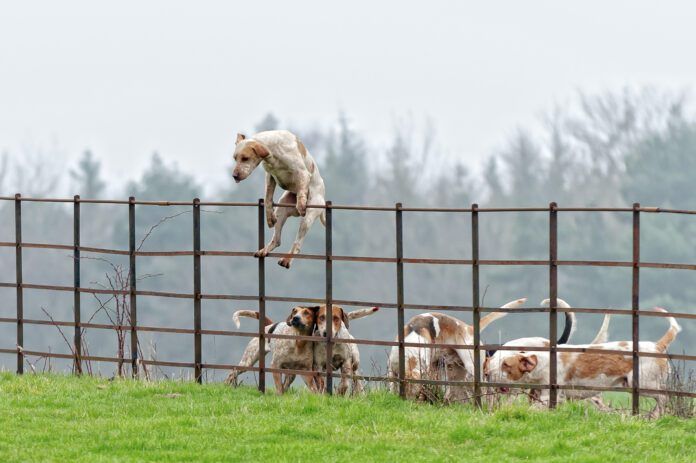
Whether you’re traveling, remodeling your backyard, or need a fence to put up at camp or at your RV, a good outdoor temporary dog fencing for dogs can keep you and your dog happy. A portable temporary fence can give your dog a little freedom, but it must be safe and secure.
But not just any old fence will do, and the internet is flooded with temporary dog fence ideas—many of which won’t give us peace of mind.
Types of quality temporary dog fences include:
- Plastic mesh
- Wire mesh
- Ex-pens, also called exercise pens
- Free-standing kennels with or without a roof
- Metal no-dig fence panels by the piece
Let’s dig into more about each of these choices.
Plastic Mesh as a Temporary Dog Fence
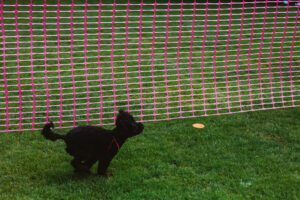
Often called snow fence or safety fence, this is typically the type of fencing that you might see at construction sites. It comes in many colors. Standard size is 4 feet high by 100 feet long but can also be purchased in shorter heights and smaller rolls.
You can use metal rods to secure it or wrap it around trees if the area supports such an option. This is what I used to patch a tree made hole in my fence until the fencing repair people could get me on their schedule. I have also used this for a temporary fence for a rescue group picnic for the dogs who came along to socialize. It is often used at dog sporting events, where the dogs are under verbal control or on a leash. This is not the best fence to choose if your dog will be unsupervised.
You can buy this type of fence online from home supply stores as well as U-Line and Amazon. There are countless brands, some of which are marketed as temporary dog fences, and some are simply sold as safety/snow fencing.
Pros of plastic mesh fencing: Relatively inexpensive, easy to use, very visible.
Cons of plastic mesh fencing: Can be difficult to secure, making it of questionable use for a determined canine escape artist, even with a secure bottom.
Wire Mesh as a Temporary Dog Fence
There are a multitude of wire mesh options, including chicken wire, which is made of flexible galvanized steel to varying strengths of welded steel mesh. The thickness determines the cost, with chicken wire being less expensive than a sturdier welded weave. This can make a very solid temporary fence along with the metal poles necessary to secure it.
Pros of wire fence: Sturdier than plastic mesh, which makes it easier to handle while installing install and a stronger choice than plastic, especially for a large dog. Woven wire chicken wire can be relatively inexpensive.
Cons of wire fence: Welded steel can be nearly as expensive and challenging to install as a permanent fence when looking at the hardier weaves. Yardgard offers quality fence in this category.
Exercise Pens as a Temporary Fence for Dogs
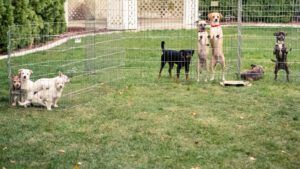
Credit: Debibishop | Getty Images
You can get several ex-pens and link them together as well as securing them to the ground with the metal rods for such that come with most models. There are also some very nice choices meant to be used outdoor models that come in various sizes, including quite large. They come in varying heights, with or without built-in gates.
I prefer them without gates. I simply open the securing connectors when releasing the dog(s). I find that to be the more secure option. Gates can be accidentally opened. The clips, when clipped properly, are far less likely to do so.
Pros of ex-pens: In many ways, this can be the most inexpensive option, especially if you find some at garage sales, and they’re oh-so-easy to set up.
Cons of ex-pens: These aren’t the most sturdy option for determined escapers. Brands that I found for outdoor use include FXW Rollick and Zippity Outdoor Products. Most are widely available with FXW even being available on Chewy. They also make indoor versions that can be used outdoors. Midwest products offers a wide variety of ex-pen options as well.
Free-Standing Kennels as Temporary Fencing for Dogs
This type of temporary fencing is exactly what it sounds like. An actual kennel, freestanding and not needing to be secured in ground, available with or without a roof. They are probably the most secure type of temporary fencing of the options, simply because the fencing for these is so high, even more secure when you opt for the type with a roof.
Pros of free-standing kennels: Kennels are generally secure, easy to set up, and self-shaded when opting for roofed version.
Cons of free-standing kennels: Kennels are expensive for a large enough option to include sufficient room to run, perhaps the least attractive option if you are not fond of the cage-like look. Brands that I liked include Veikhous, Retriever Lodge, KennelMaster, and K9 Kennelstore.
Metal No-Dig Fence Panels as Temporary Fencing for Dogs
I found this to be a most interesting option for a temporary dog fence. Some of the options don’t really specify the type of metal used but other options mention wrought iron. All state there is no need to dig to install and that only a rubber mallet is necessary to pound each piece into place. They range in heights from 24 inches to 48 inches. You choose how many panels to purchase and that determines the total cost.
Pros of metal no-dig fence panels: They’re easy to install and relatively inexpensive compared to some other options, sturdy if you choose wrought iron.
Cons of metal no-dig fence panels: The lack of posts concerns me, as it can make this option much less secure. Brands for this option include Zippity Outdoor Products and Jinligogo (wrought iron option).
Considerations In Choosing a Temporary Dog Fences
Some important points to take into consideration that can help you choose the best option for your dog, the location of the fence, and how long you’ll need to use it.
Height of the fence: For smaller dogs, 4 feet is sufficient. Large dogs may need 6 feet. Keep in mind that most experts suggest that a dog can jump one to three times his shoulder height. Additionally, many dogs can and will scale a metal fence easily, especially younger dogs.
Sturdiness of the fence: Your dog should not be able to wobble the fence or tip it over by jumping on it or leaning against it.
Your dog’s climbing/digging abilities: If your dog is an expert climber or digger, then this means special additions for your temporary fence are necessary. For your darling digger, I love Dig Defence. For the climbers, you can consider a Coyote Roller. If you’re clever, y ou may be able to do a DIY version using inexpensive PVC as opposed to the original metal version. Originally created to keep coyotes out of fenced-in areas, it also keeps your climbing canine monkey inside.
Your dog’s energy and activity levels: If you have an adolescent who considers zoomies light cardio, then you need more room than if you have a senior who just wants to sit/lay outside and meditate with nature. Of course, this also depends on how you intend to use the fence.
Your dog’s reactivity level: If your dog is the type to bark or react in any way to typical triggers that may include other dogs, passing humans, children playing, bicycles/wheeled recreational toys, cars, etc., then what they see from inside of the fence is an important consideration for the type or fencing as well as the location of such. Again, this will depend on how you intend to use this temporary fence.
Typical Uses for a Temporary Dog Fence
All the above-mentioned options can be successfully used on a temporary basis while remodeling or saving up for a permanent fence. Some will require more supervision than others, such as the snow fence, no-dig panels, and ex-pen options.
If you are installing this temporary fence on grass or dirt, which is the typical choice, then metal with secured poles will be the sturdiest choice but also the most labor intensive to install. This is the way to go if you have a large sturdy dog who will challenge the fence. Add the Dig Defence options for diggers or the Coyote Roller top for climbers.
But if you truly want this fence to be temporary and as low maintenance as possible, the best prevention for digging is simply supervision. One cannot say the same for jumpers, who will jump whether supervised or not. So, choose as tall a fence as appropriate for your beloved jumper. For your reactive dog, you can easily cover the metal fence with privacy screen made from polyethylene mesh.
The kennel options can be placed on either a grass surface or a concrete surface such as a driveway, if you are remodeling your yard. This option requires the least supervision, if you properly secure it, but it’s also typically the most confining option, which is not ideal depending on your needs.
For traveling, the choices are less abundant. How you are traveling determines the size of your temporary fence. The larger options can be stored on an RV/motor home. Smaller options can be transported on a roof rack. Most of the travel options are basically larger metal ex-pen type containment systems that are suited for outdoors rather than indoors. Or you can link several smaller ex-pens together to create a larger area, along with the metal yard poles that typically come with the pens. There are also very lightweight interlinking plastic ex-pen options for smaller or more sedate dogs. Several of the No Dig Panels are marketed as RV fences for traveling. Supervision is recommended for these types of temporary fences, especially since traveling can add some excitement or anxiety to your dog’s typical temperament.
Whatever option you end up with, think in terms of safety and cover all your bases—climbing, jumping, digging—and you should be able to keep your dog safe, temporarily, of course.
Can Dogs Have Panic Attacks?
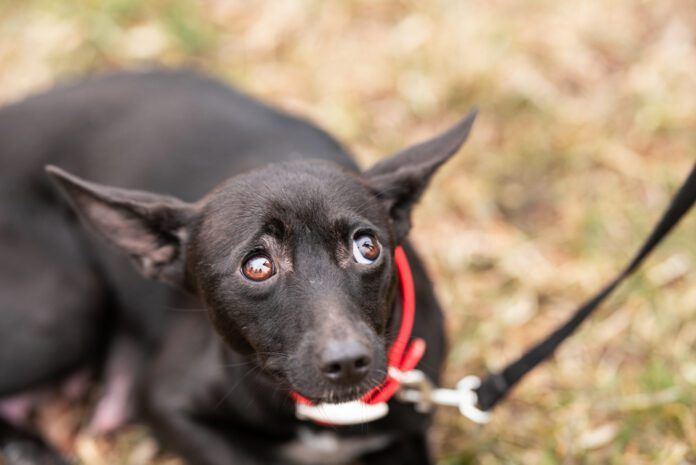
Join Whole Dog Journal
Already a member?
Click Here to Sign In | Forgot your password? | Activate Web AccessWhy Is My Dog Eating Leaves?
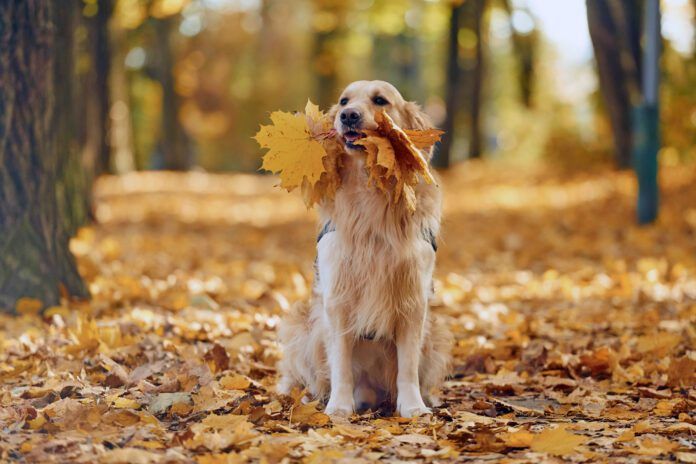
More to the point, can your dog eat leaves? In most cases, the answer is no! Some leaves are toxic. Most leaf chewing is done in an exploratory way by puppies, and they aren’t really going all out and “eating” leaves. Dogs may also chew on leaves out of boredom.
For example, foxglove and oleander contain digitalis-like toxins that may affect the way heart’s ability to beat normally. With oleander, even one or two leaves could be fatal to your dog. There are even accounts of dogs dying after drinking from a water bowl that had oleander leaves blown into the bowl.
Many plant leaves are not deadly for dogs, but their leaves may cause gastric irritation, diarrhea, and vomiting.
Locust tree leaves may be deadly. Oak leaves are not usually deadly, for example, but can cause lots of gastrointestinal symptoms.
Can dogs run and play in leaf piles? Yes, and many dogs love to do that. Be aware, however, that the leaf pile may contain fleas or ticks because they gravitate to those piles too. While playing in a leaf pile, your dog may grab and toss leaves, but they don’t usually ingest them.
Why Do Dogs Chew on Plants?
It may be to add fiber to their diets. While you could grow a safe mini grass plot like many cat owners do, it is simpler to add some plain canned pumpkin to your dog’s diet.
Why Do Dogs Eat Sticks?
Sticks seem to be an attractive play toy. Many dogs chew on sticks because they are handy, especially if your dog is out in the yard and bored, and because you throw them. While a sturdy, non-toxic stick may be relatively safe for your dog to chew on, if he is ingesting wood that can cause problems down the road. Sticks from poisonous trees and plants are toxic, so unless you know for sure, it’s best if your dog doesn’t play or consume stick pieces.
Despite the fun your dog can have with a stick, it is best to avoid getting your dog “hooked” on them. Dogs have knack for getting short pieces of sticks stuck on the roof of their mouth. You will see your dog drooling, panting, and pawing somewhat frantically at his mouth. If your dog is relatively calm, you may be able to remove this yourself but if he is frantic, be careful or you may get bitten by accident.
There are many horrifying tales of dogs running with sticks and accidentally impaling themselves. Those injuries can range from minor emergency room visits to serious surgeries or even death.
How to Stop Dogs From Chewing on Sticks
In addition to adding plain pumpkin to your dog’s diet, make sure your dog has plenty of safe chew items.
Sturdy chew toys can safely take the place of sticks. For my dogs, Kong products tend to survive the best. Most “tough” stuffed type toys are destroyed quickly. West Paws toys also hold up well. Even with these tough toys, I try to check every day or so for any ripped off areas or places where the dogs are chewing little pieces off.
Pet-Friendly Weed Killers
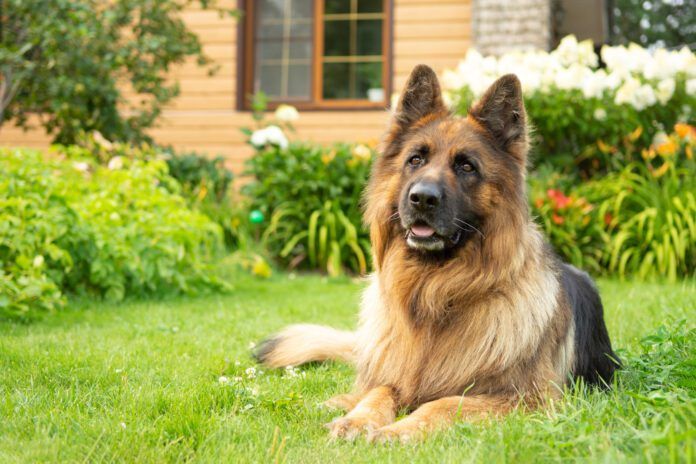
Join Whole Dog Journal
Already a member?
Click Here to Sign In | Forgot your password? | Activate Web AccessWhat Are the Best Dog Exercises for Canine Conditioning?
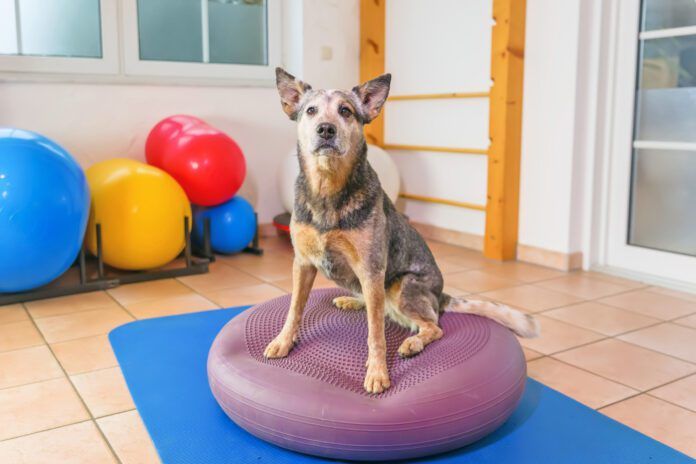
All dogs can benefit from dog exercise of some sort, but especially canine conditioning, as it’s appropriate for canine athletes as well as senior couch potatoes and everything in between and beyond, including puppies.
Last summer, I helped a client keep her pup physically exercised while we were going through an intense heat wave in my area. Walks in her neighborhood were out of the question due to hot pavement. The yard was great for short ball play, but the dog needs more than that. That led me down the rabbit hole that is canine conditioning, and I am hooked on this subject. I had no idea that there were so many ways to physically condition dogs with simple but effective exercises like what humans do.
Obviously, before you begin any sort of exercise program for your dog, get approval from your veterinarian. Knowing what to avoid for your pup is important to staying safe, especially if you have a dog with even a tiny bit of arthritis or any kind of joint issues. It also helps to obtain at least a baseline education on dog anatomy. Puppies should not be participating in anything that involves jumping, running on hard surfaces, or balancing until their bones are fully formed.
For dogs who can do cardio, that is a great part of a fitness program. Cardio is anything that uses more lung capacity such as running, swimming, jogging, fetch, agility, and other dog sports. But cardio alone is not canine conditioning.
Fast twitch muscles are utilized in short but intense movements such as the zoomies, intense tug exercises, jumping stair climbing, juking back and forth, and so on.
Canine conditioning for dog sports generally includes specific strength training and/or stretching exercises for the individual sport that a dog is participating in. While strengthening the muscles needed for that sport, it is important to consider the SAID principle, which is equally a consideration for human physical conditioning and strength training.
SAID stands for Specific Adaptation to Imposed Demands. It is believed that muscles, tendons, ligaments, and bones respond to purposeful stress by getting stronger. The physical patterns that are used in each sport being replicated by training gets the body used to those movements. In dog behavior modification, we call this creating new nerve patterns. I expect that it will be similar here. See this website for more on this subject
Now let’s delve into how some of these strength training/stretching exercises can be done at home, even if your dog is not participating in sports. Truly, all dogs can benefit from strengthening their core and muscles.
Stretching Exercises for Dogs
Natural stretches: You can capture your dog stretching when they do it naturally by using a marker word or clicker, if they already know what that means. Once they understand what you are marking, you can put it on cue. My puppy often moves into a sit from a down in to stretch his upper body and his neck, as well as stretching his front legs out with his toes extended. These are excellent stretches to capture. Some people teach their dogs to offer a play bow on cue, and that is also a stretch. The possibilities are nearly endless. Once you mark the behavior consistently, name it to put it on cue.
Figure 8s: Walking in figure 8s like you might do in Rally or zigzagging through weave poles are also versions of stretching. If you’re not training agility, you can lure your dog through poles with either a treat in your hand or a target stick to start. That will also work with figure 8s. Placing objects that you want to curve around for figure 8s will help your dog better understand this process.
Balancing Exercises for Dogs
Teaching your dog to place all four paws on a stable surface is how you start this process. Most dogs already have some sort of cue or even just an inclination to jump up on raised surfaces. If your dog doesn’t, make sure that the initial surface is low enough to not be uncomfortable for that dog. I simply use an “up” cue. Once this is mastered, consider a less stable surface such as a pillow for a small dog or the couch or a large dog bed for a larger dog. The trick here is to work with the dog standing on that surface rather than laying down.
If you have not already taught your dog to stand on cue, start there. I use a flat hand, palm down with fingers tight together, and move my hand face down horizontally from the dog’s nose when they are seated with a small treat between my fingers. I mark the moment that the dog is on all fours and then food reward and then add the cue word when it’s consistently being followed. Make sure that your dog feels safe on the surface with all four paws before you add the cue for this. Balancing uses their muscles in such a way that they strengthen their core. If your dog is more athletic, use a balance/wobble board or even make one with a hard flat surface with a ball underneath one end.
Strengthening Exercises for Dogs
A popular exercise in puppy classes is puppy pushups (also called “puppy aerobics”). This is one of the easiest ways to strengthen your dog with low impact. First get that sit, and then the down. Repeat. You can add a stand in there as well for even more strengthening exercise. Make sure that you are naming/marking/rewarding each step.
If you have ever taken a fun agility class, you have likely seen some of the equipment that can double as conditioning equipment. These include wobble boards, low-set teeter totters, the A-frame (lowered), weave poles, low jumps, ladder walks, and the like. All of these tools help teach body awareness.
Not all of these are right for all dogs needing conditioning, of course. Puppies and senior dogs don’t need to do jumps, teeter totters, or anything that can affect mobility issues. Wobble boards can scare some dogs so there are other options that can achieve the same results such as the soft surfaces mentioned above. Ladder walks teach paw/spatial awareness and help with stability control.
Physical conditioning exercises will keep your dog in top shape while exercising both their body and mind. It’s important to make all the exercises fun with treats for a job well done, never over face your dog with too many repetitions or obstacles he’s not ready for, and—of course—safety first.
What You Need to Know About Anemia in Dogs
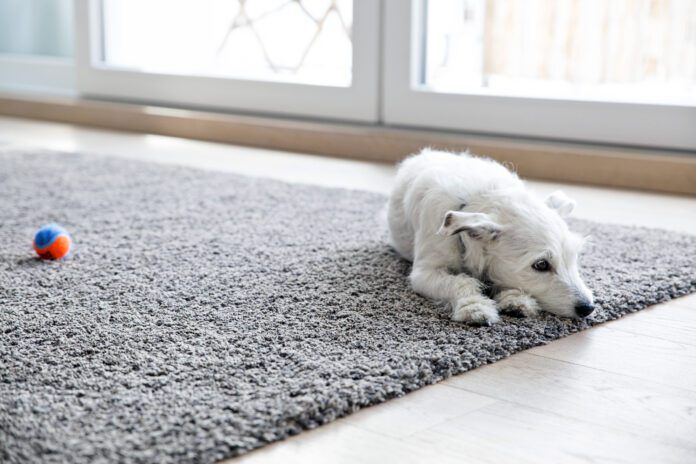
Anemia in dogs is defined as a deficiency of red blood cells. Red blood cells deliver nutrients and oxygen to cells and organs and carry carbon dioxide to the lungs to be exhaled. Without adequate red blood cells, your dog’s heart and lungs go into overdrive to try to make up for the lack of oxygen in the dog’s body and keep the body functioning. Anemia is serious.
Join Whole Dog Journal
Already a member?
Click Here to Sign In | Forgot your password? | Activate Web AccessHow To Soothe a Dog’s Irritated Anus
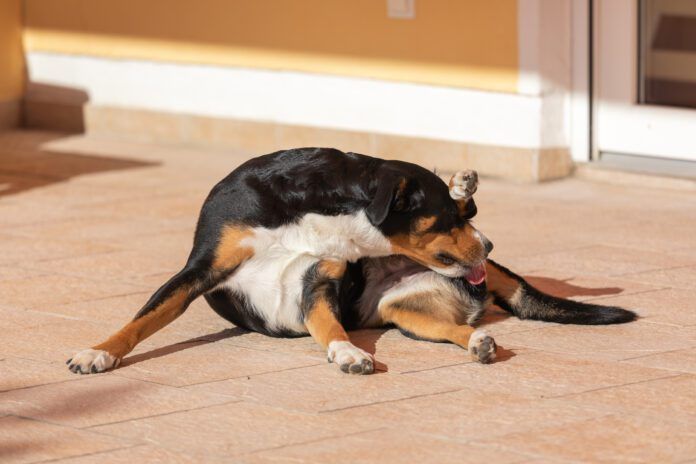
Things you never thought you’d do an internet search for, right? But if your dog keeps licking his butt, he’s going to need a little help from you to get some relief. When a dog’s anus is red and irritated, the key is to soothe those delicate tissues without causing harm and then get to the bottom of the problem.
Quick Relief for a Dog’s Irritated Anus
When it comes to how to soothe your dog’s irritated anus quickly, you can provide some relief safely and easily at home using the following methods:
- Clean the affected area with a warm, damp cloth or pet-safe wipes.
Many of the causes of anal irritation are messy. If your dog has dried poop, scabs, or pus on his back end, removing this debris can make him feel a lot better. Be gentle when cleaning, as an irritated butt can be painful. It may help to soak caked-on debris to soften it before trying to remove it.
- Apply a warm compress.
Hold a warm, damp cloth over the irritated area for 5-10 minutes. This can help to soothe your dog’s anus. It is better to err on the cooler side with the compress, as applying a hot cloth could burn the sensitive skin and cause more damage. You can test the temperature on your wrist or lips—if it’s too hot for you, it’s too hot for the dog.
- Apply a pet-safe ointment.
If you have a pet-safe ointment on hand, you can apply a thin layer to the irritated area around the dog’s anus. I really like Veterinus Derma GeL for any small wound—it is easy to use, safe if the dog licks it, and provides both some antimicrobial effect and pain relief.
Why a Dog Might Keep Licking His Butt
For long-term relief, you will need to figure out why your dog’s anus is red and irritated. Some common reasons include:
Diarrhea
Diarrhea isn’t fun. It is uncomfortable and repeated episodes of diarrhea can irritate your dog’s anus. Loose poop getting stuck in the hair and on the skin around the anus only worsens the discomfort.
If your dog is having diarrhea, make sure his bum is clean each time he finishes pooping. A damp cloth can handle small messes but washing off with a hose outside or in the bathtub may be necessary for bigger catastrophes. Keeping his skin clean will help to prevent further irritation.
Diarrhea can be caused by many different things, ranging from eating something foolish to intestinal parasites or viral illnesses. If your dog overall seems happy and healthy, you can withhold all food for 12 hours and then feed a bland diet for a day or two. If the diarrhea lasts more than two days, it’s time to make a vet appointment. Diarrhea and vomiting at the same time is an emergency.
Anal Gland Issues
The anal glands are two sacs located just inside your dog’s anus. Normally they express a little stinky liquid each time your dog defecates. But sometimes they can become overfilled, impacted, or even infected. This is uncomfortable!
The classic sign of anal gland issues is a dog scooting his butt across the ground. Your dog may also lick or chew at his rear end in an effort to relieve the pressure. Scooting, licking, and chewing all irritate the skin around the anus, and can make the discomfort worse.
Minor anal gland impactions can be resolved with manual expression. You can learn to do this yourself at home or you can schedule an appointment for your vet or a vet tech to do it. Manually expressing the anal glands relieves the pressure from the overfilled gland, allowing your dog to get back to business as usual. The color, odor, and texture of the contents can also tell your vet if your dog might have an infection or other problem with the glands.
While waiting for a vet appointment, you can soothe your dog’s irritated anus by applying a warm compress for 5-10 minutes several times a day. This will provide some pain relief and may help to loosen the anal gland contents and make your dog more comfortable.
For many dogs, this is a one-time misfortune. However, some dogs are prone to chronic anal gland issues and may need regular manual expressions, increased fiber in their diet, or in rare cases a surgical procedure. If your dog is frequently scooting his butt or chewing at his back end, it’s time to call your vet.
Allergies
While humans with allergies sniffle and sneeze, dogs scratch and chew. The butt, ears, and paws are common areas where dogs with allergies get red, itchy skin.
If your dog has seasonal allergies, you will only notice his perianal area being irritated at specific times of year. For example, early fall is a common time for many dogs’ seasonal allergies to flare up. Other environmental allergies—such as allergies to dust, indoor allergens, or trees—can be a problem year-round. Food allergies are also consistent and do not let up with the changing of the seasons.
Your veterinarian will help you determine if your dog’s itchiness is due to allergies and parse out whether the cause is likely food, environmental allergens, or a combination of both. She will also diagnose and treat any secondary infections that may have taken advantage of your poor dog’s compromised skin.
Food allergies are treated with diet trials to determine which ingredient(s) give your dog trouble. It can take several months to see complete improvement, but stay the course—it will be worth it once you know what foods your dog tolerates best.
Diphenhydramine (Benadryl) is an easy way to provide relief for some dogs experiencing an itchy butt from environmental allergies. A general guideline for dogs is one milligram of Benadryl per pound of body weight (meaning a 25-pound dog would get one 25mg tablet) but call your vet to get an exact dose for your dog. Loratidine (Claritin) and cetirizine (Zyrtec) are also helpful for some dogs.
Unfortunately, many dogs with environmental allergies require a more robust, dog-specific treatment plan to keep them itch and irritation free. This may include medicated shampoos, the monthly injectable medication Cytopoint, or the tablets Apoquel or Zenrelia. It can take some trial and error to determine the best treatment plan for your dog, but his itch-free butt will thank you for your persistence.
Fleas
Fleas can bite anywhere on a dog’s body but often focus on the hind end. Each bite is itchy, and dogs with flea allergy dermatitis will experience dramatic swelling, redness, and itchiness all along the back end of the body from even a single bite.
If your dog’s anus is irritated and itchy due to a flea infestation, the solution is to give your dog a bath with Dawn dish soap and then give a prescription-grade flea preventive medication for three consecutive months. Don’t forget to vacuum your house and wash bedding thoroughly to remove any flea eggs or larvae hiding there.
Perianal Fistula
Perianal fistulas are painful draining tracts that can occur around a dog’s anus. You will notice an extra hole or two that has a bloody or pus-like discharge. If you suspect your dog has perianal fistulas, it’s time to make a vet visit.
Perianal Tumor
Dogs can get cancer near the anus. Tumors in this area are more common in intact male dogs, and neutering can often resolve the issue if it is a benign tumor. Malignant tumors and ones in female or neutered male dogs will likely require surgical removal.
While waiting for a vet appointment, you can provide relief for your dog’s anus by applying a dog-safe ointment to the irritated area.
When To See a Vet About a Dog’s Irritated Anus
A dog who keeps licking his butt should see a vet if:
- He is having diarrhea for more than two days, or has other signs of illness (diarrhea and vomiting is an emergency)
- He scoots his butt frequently
- He has sores or wounds around the anus
- There is bleeding or draining pus coming from anywhere around the anus
- Itchiness and irritation persists
- He has a new lump in the area that seems to be bothering him
Top Couch Covers for Dogs

Join Whole Dog Journal
Already a member?
Click Here to Sign In | Forgot your password? | Activate Web AccessPractical Dog Clothes
